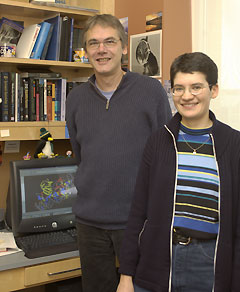|
This is an archived article.
For the latest news, go to the
Advance Homepage
For more archives, go to the Advance Archive/Search Page. | ||
|
Microbiology Challenges Long-Held Like detectives working with ancient clues, Professor Johann Peter Gogarten and his students use modern genetic tools to illuminate the early days of life on Earth, a period that dates back 3.8 billion years.
A molecular biologist by training, Gogarten studies the evolution of microorganisms from the very dawn of time. His work is challenging beliefs that have long been bedrock biology, ever since Darwin introduced the concept of species evolution as a steadily branching "Tree of Life." Since 1989, Gogarten has been taking molecular and cell biology students at UConn on a journey that might have been imagined by H.G. Wells. His classes focus on molecular evolution and molecular biology, often through the world of so-called "simple" one-celled life forms - whose not-so-simple genome would take 400 pages if printed out. Students learn how more complex organisms came about, and how proteins - the main component of cellular machinery - arose early in life, and how they arise today. "The goal of my classes is to prepare biologists for the genomic age," Gogarten says. Gogarten was among the first to recognize that horizontal gene transfer is so frequent that the Tree of Life paradigm is in trouble. Horizontal transfer of genes differs from the traditional way of inheriting traits "vertically" from a parent or ancestors. Lateral transfer, Gogarten and other scientists say, created the machinery that is used by bacteria to perform oxygen-producing photosynthesis. About 2,300 million years ago, this photosynthetically produced oxygen changed the face of our planet, poisoning many organisms living at the time, while allowing the emergence of other organisms that use oxygen in respiration. Today's multicellular organisms became possible only through the large amounts of energy gained in respiration. An analysis of five photosynthetic types of bacteria by Gogarten's lab showed that gene transfer was instrumental in inventing oxygen-producing photosynthesis. This and other analyses contributed also to thinking that the Tree of Life wasn't really a tree at all. "It's more like a network than a tree, given that horizontal gene transfer is taking place among very diverse organisms," Gogarten says. "In the world of animals, that would be like a giraffe sharing its genes with an elephant to produce a long-necked elephant that could graze for leaves at the top of trees. That doesn't happen with animals, but things like that do happen all the time with bacteria and other microorganisms." The study of how genes can pass between divergent organisms not only brings evolutionary activities from eons ago into sharper focus; it also assists with modern issues that touch on botany, medicine, and food production. Consider, for example, the implications of the mischievous behavior of a soil-borne pathogen called Agrobacterium tumefaciens. It enters a plant through a wound site and inserts a segment of its own DNA into the plant's genome. The transferred genes cause a tumorous proliferation of plant cells that instruct the plant to produce compounds containing the carbon and nitrogen on which Agrobacterium lives. While this transfer from single-celled to multicellular organism is rare, it occurs on a regular basis between microorganisms. A native of Germany, Gogarten began studying how cells take up molecules from their environment as a graduate student. He looked deeper into the issue and soon was pondering a related topic, the evolution of proteins that function as transporters. "Since then, I've been hooked," he says. Because fossil evidence from 3.8 billion years ago is scarce, Gogarten and his students use genes and genomes from present-day organisms and extrapolate backwards using specialized computer programs. The professor's website is filled with resources and links, as well as quizzes and a section that allows students to ask him questions about complex topics as gene sequencing, taxonomic groups, and genetic algorithms. Gogarten's students often continue in academia, or they find a professional home in the pharmaceutical industry, working perhaps in gene therapy or drug delivery system research, or devising ways of breeding better crops using genetic and genomic research. Much of the activity in Gogarten's laboratory is focused on the origin of eukaryotes, the kingdom of life that includes all the higher plants and animals, including humans. Microfossils in sedimentary rock dating back 3.8 billion years reveal microscopic colonies of what might be called bacteria. But if they were already abundant then, where did they come from and what was their ancestor? Questions like these are leading Gogarten and other researchers around the world to redraw Darwin's Tree of Life in a very different way. The three forms, or domains, of life are bacteria (including those capable of photosynthesis), eukaryotes, and archaea, another type of bacteria. There may have been two primary lines of descent, the common bacteria on one branch and the archaea and eukaryotes on the other. Researchers in Gogarten's lab discovered that the three domains of life arose through a different series of steps than had previously been believed. Around the world, Gogarten and his colleagues pore through massive databases, analyzing and comparing the genomes of different life forms invisible to the naked eye, trying to shed light not on one of the great mysteries of life, but literally on the great mystery of life. The relationships among these microscopic, one-celled organisms go beyond "elusive" for most people. But Gogarten, his students and colleagues around the world are patient, persistent, and dedicated, knowing they are part of a scientific endeavor that really began only in the 17th century, when Anton Van Leeuwenhoek, a Dutch lens maker, first stared through a simple microscope at mysterious microbes. Centuries later, their relationship to mankind continues to fascinate. |

